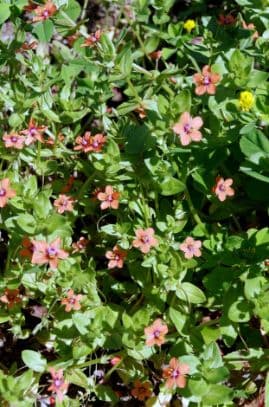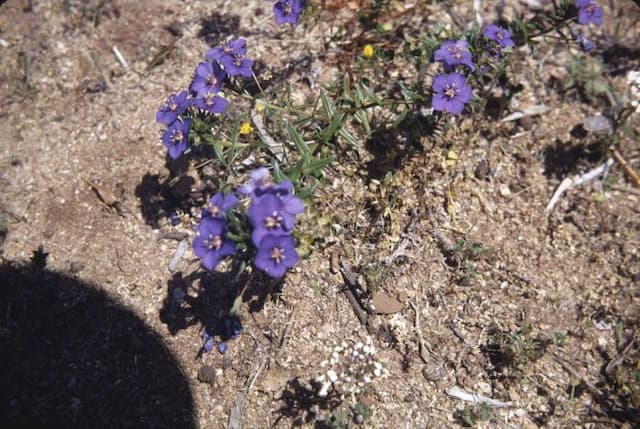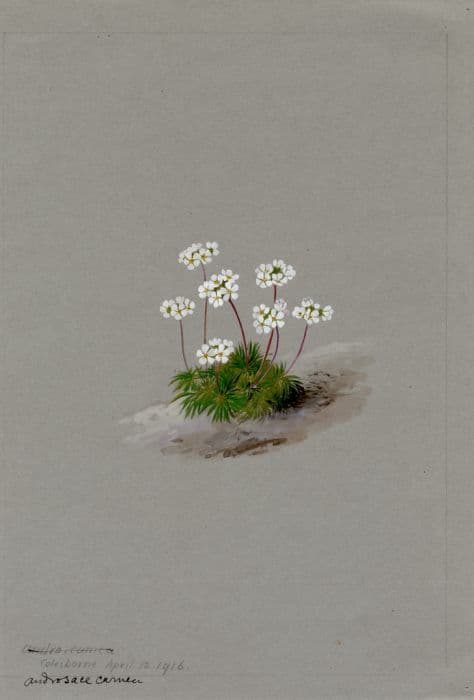Japanese Primrose Primula japonica 'Alba' (Pf)

ABOUT
Primula japonica 'Alba' is a charming plant featuring delicate, white flowers that sit atop long stems with a tiered arrangement, giving it a somewhat stacked appearance. Each flower is a soft, pure white color and comprised of round to heart-shaped petals surrounding a yellow center, creating a lovely contrast. The blooms are typically carried in whorls spaced out on the stalk. Below the blooms, there is a basal rosette of textured, green leaves that are often oval to spoon-shaped with a slightly wrinkled or crinkled texture. These leaves form an attractive mound of foliage from which the flower stems rise. The overall appearance of Primula japonica 'Alba' is one of grace and soft beauty, with its snow-white flowers contributing a feeling of tranquility to the garden.
About this plant
 Names
NamesFamily
Primulaceae.
Synonyms
Japanese Primrose, Candelabra Primrose.
Common names
Primula japonica 'Alba' (Pf).
 Toxicity
ToxicityTo humans
The Japanese primrose (Primula japonica 'Alba') is considered non-toxic to humans. There are no significant toxic effects reported from ingesting this plant.
To pets
The Japanese primrose (Primula japonica 'Alba') is also considered non-toxic to pets such as dogs and cats. This plant is not commonly associated with poisoning in pets, and there are no widespread reports of significant toxicity from ingestion.
 Characteristics
CharacteristicsLife cycle
Perennials
Foliage type
Deciduous
Color of leaves
Green
Flower color
White
Height
1-2 feet (30-60 cm)
Spread
1 foot (30 cm)
Plant type
Herb
Hardiness zones
5
Native area
Japan
Benefits
 General Benefits
General Benefits- Aesthetic Appeal: The Primula japonica 'Alba', commonly known as Japanese Primrose, has elegant white flowers that provide a delicate and sophisticated look to gardens.
- Attracts Pollinators: It serves as a food source for bees, butterflies, and other pollinators, thus contributing to the health of your garden ecosystem.
- Low Maintenance: Japanese Primrose is relatively easy to care for, requiring minimal maintenance once established, making it ideal for gardeners of all skill levels.
- Shade Tolerance: It thrives in partially shaded areas, which makes it suitable for planting under trees or in other shaded parts of a garden.
- Moisture Loving: Prefers wet or moist environments, making it a great choice for waterside plantings like pond edges or stream banks.
- Seasonal Color: Blooms in the spring to early summer, providing seasonal color when many other plants are not in flower.
- Naturalizing: It can spread over time to form natural-looking drifts, which can be particularly charming in woodland or cottage gardens.
 Medical Properties
Medical PropertiesThis plant is not used for medical purposes.
 Air-purifying Qualities
Air-purifying QualitiesThis plant is not specifically known for air purifying qualities.
 Other Uses
Other Uses- Edible Flowers: The blossoms of the Primula are edible and can add a delicate flavor and decorative touch to salads and desserts.
- Photography Subject: With its striking white flowers, Primula japonica 'Alba' is a popular subject for botanical photographers and artists.
- Nature Crafts: The flowers can be used in pressed flower projects or to create botanical prints.
- Educational Tool: Primula japonica 'Alba' is used in schools and educational programs to teach plant life cycles and botany.
- Garden Design: This plant is used as a thematic element in moon gardens—gardens designed to be enjoyed in the twilight hours.
- Companion Planting: Primula can be planted alongside other moisture-loving plants to create a diverse and supportive ecosystem in the garden.
- Water Feature Accents: The plants are suitable for placing around ponds or water features for an enhanced natural aesthetic.
- Cultural Symbolism: In certain cultures, Primula is a symbol of youth and everlasting life and is used in cultural ceremonies and artworks.
- Container Gardening: It makes an excellent choice for container gardening due to its compact size and attractive foliage.
- Hobby Greenhouses: Enthusiasts of temperate flowers often cultivate Primula japonica 'Alba' in hobby greenhouses to enjoy their blooms year-round.
Interesting Facts
 Feng Shui
Feng ShuiThe Candelabra Primrose is not used in Feng Shui practice.
 Zodiac Sign Compitability
Zodiac Sign CompitabilityThe Candelabra Primrose is not used in astrology practice.
 Plant Symbolism
Plant Symbolism- Youth: The primrose, being one of the first flowers to bloom in spring, symbolizes youth and renewal.
- Hope: The bright and early blossoming of the primrose signifies hope and the anticipation of better times to come after a long winter.
- Happiness: The cheerful appearance of the primrose is often associated with joy and the lifting of one's spirits.
- Love: In the language of flowers, primroses can represent young love or love in its early stages, symbolizing affection and adoration.
- Perseverance: The primrose's ability to thrive in cool climates represents the trait of perseverance and overcoming challenges.
 Water
WaterThe Japanese Primrose should be watered consistently to keep the soil moist, but not waterlogged. It is best to water this plant when the top inch of soil feels dry to the touch, which could be once or twice a week depending on climate conditions. Use room temperature water, and aim to provide about one to two gallons per week during active growing seasons, adjusting for rainfall and temperature. During the winter dormant period, reduce watering, but do not allow the soil to completely dry out.
 Light
LightFor optimal growth, the Japanese Primrose prefers bright, indirect light or partial shade. A spot that receives morning sun with afternoon shade or dappled sunlight throughout the day is ideal, particularly in areas with hot summers. Too much direct sunlight can scorch the leaves, while too little can result in poor flowering.
 Temperature
TemperatureThe Japanese Primrose thrives in cooler temperatures, ideally between 50 and 70 degrees Fahrenheit. It can tolerate temperatures as low as 40 degrees Fahrenheit, making it suitable for cooler climates and outdoor gardens. To encourage flowering and robust growth, maintain the plant in its preferred temperature range and protect it from extreme heat.
 Pruning
PruningPrune Japanese Primrose after flowering by removing spent blooms and dead leaves to promote healthy growth and possibly encourage a second bloom. Generally, this plant should be tidied up in the late fall or early spring, which is also the best time to divide and transplant if necessary. Regular removal of damaged or yellowing leaves will keep the plant looking its best.
 Cleaning
CleaningAs needed
 Soil
SoilJapanese Primrose 'Alba' thrives in moist, well-draining soil with rich organic matter and prefers slightly acidic to neutral pH levels of around 6.0 to 7.0. A mix of peat, garden soil, and perlite or sand can create an ideal substrate for this plant.
 Repotting
RepottingJapanese Primrose 'Alba' should generally be repotted every 1 to 2 years to replenish the soil and accommodate root growth. It's best to repot in spring before the new growing season begins.
 Humidity & Misting
Humidity & MistingJapanese Primrose 'Alba' prefers high humidity levels but tolerates average household humidity. It fares well with humidity levels above 50% to replicate its natural damp woodland habitat.
 Suitable locations
Suitable locationsIndoor
Keep Japanese Primrose 'Alba' in bright, indirect light, with high humidity.
Outdoor
Plant Japanese Primrose 'Alba' in part-shade, moist, well-draining soil.
Hardiness zone
4-8 USDA
 Life cycle
Life cyclePrimula japonica 'Alba', commonly known as Japanese primrose, begins its life as a seed, which germinates in cool, moist conditions in spring. The seedling develops into a rosette of leaves at the soil surface, where it may remain through its first year, establishing a strong root system. As the plant matures, it sends up a flower stalk with tiers of delicate white flowers in late spring to early summer of the second or third year. After pollination, typically by insects, the flowers develop into seed capsules that release seeds to propagate the next generation. In the winter, the plant dies back to the ground, surviving as a perennial rootstock. With the return of warmer temperatures, the rosette re-emerges, continuing the cycle.
 Propogation
PropogationPropogation time
Spring-Early summer
Primula japonica 'Alba', commonly known as Japanese Primrose, is best propagated by division, a process often done in late summer to early fall. To propagate through division, carefully dig up the clump of the plant ensuring to keep a good amount of soil around the roots. Gently tease the clump apart into smaller sections, making sure that each new section has both roots and shoots. Replant these divisions immediately into well-prepared soil, ideally enriched with compost, spacing them about 12 inches (approximately 30 centimeters) apart to allow for spreading. Water the new plants thoroughly after planting to help them establish. Division is the most popular method as it helps to rejuvenate older clumps that may have become woody in the center and it rapidly increases the number of plants.









